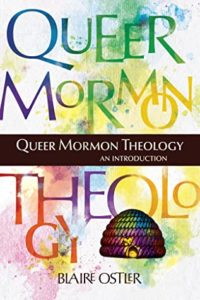 Title: Queer Mormon Theology: An Introduction
Title: Queer Mormon Theology: An Introduction
Author: Blaire Ostler
Publisher: By Common Consent Press
Genre: Theology
Year Published: 2021
Number of Pages: 152
(Reviewed by Erik Champenois)
Queer Mormon Theology: An Introduction is a beautiful book that shows just how beautiful an expansive version of Mormonism can be. Using the word “queer” to simultaneously describe her own identification, as an umbrella term for the LGBTQIA+ community, and as describing the peculiarity of God’s people, Blaire shows how queer Mormonism is and can be.
The first couple of chapters lay some groundwork in describing Mormon theology – little here is new to any LDS reader other than shining a queer perspective on the fundamentals of LDS teachings. In Chapter 3, this queer perspective beautifully moves on to the topic of Jesus Christ and His Atonement, describing the Atonement as a “queer experience” through which Jesus became “both male and female, cisgender and transgender, agender and pangender, black and white, strong and weak, heterosexual and homosexual.” No other symbol or standard is more beautifully representative of a more queer-inclusive form of Mormonism than this description.
Chapters 4 and 5 cover Mormon theology and teachings on the family, sexuality, and creation. Describing the LDS Church’s portrayal of queer people as villains as “a war that does not need to be fought,” Ostler presents a more inclusive reading of the Family Proclamation and the queer experiences of gender dysphoria and gender euphoria as representing promptings from the Holy Ghost. She covers how reproductive technologies are allowing people to become co-creators of children in ways not possible in the past. She then reviews scriptural accounts of queer creation: three men (Elohim, Jehovah, and Michael/Adam) creating Eve, Eve being created from a man’s body, and Mary giving birth to Jesus without intercourse. With these scriptural accounts as examples and templates, why should we limit creation in the eternities to heterosexual marriages?
Chapter 6, “Concerning Polygamy,” is the most controversial chapter in the book. Ostler here argues for a more inclusive, Queer Polygamy model as opposed to the Standard Model (how early LDS polygamy was actually practiced) – including an understanding of LDS “sealing” as encompassing not just marriage, but all relationships of all kinds. One leaves this chapter feeling that, paradoxically, the peculiar historical institution of LDS polygamy actually presents a potential opening towards a more queer-inclusive theology not shared by other conservative Christians.
Ostler’s last chapter covers current Church policies, including the Exclusion Policy and the current belief in “celestial conversion therapy” (with queer people being “fixed” in the after-life). She also presents 15 ways for readers to make Church today more inclusive of LGBTQIA+ people, regardless of current Church policies – helpful recommendations for any lay member or leader seeking to make Church more inclusive.
A deeply personal book, Ostler frequently describes her own life experiences as a queer member of the Church, making her reflections on queer Mormon theology all the more powerful. Her writing is beautiful, thoughtful, and inspiring. Hers is a perspective much needed in the Church today. As a heterosexual male, she definitely helped me see LDS teachings from a different perspective, enriching my own understanding of Mormon theology in the process. Highly recommended for all readers seeking to understand and embrace LGBTQIA+ people in the Church today.
